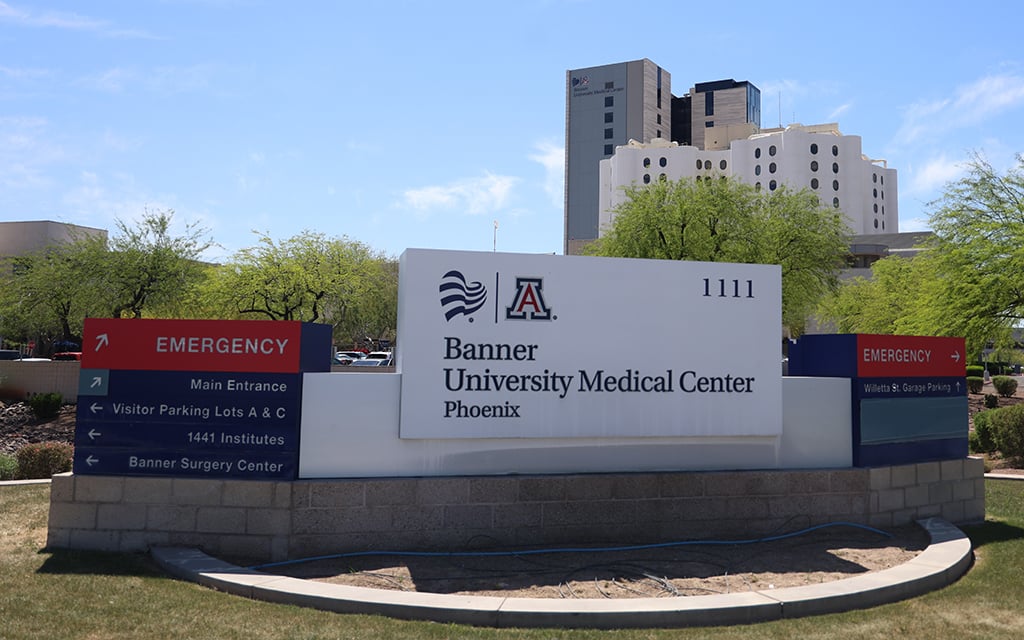
Banner University Medical Center, where Dr. Harvey Hsu works as medical director of ambulatory internal medicine, offers a long-COVID treatment program. (Photo by Jack Orleans/Cronkite News)
PHOENIX – Andrew Archer has been recovering from COVID-19 for almost four years.
“My life is so different (now), and I’m slowly starting to accept that,” Archer said. “It’s like losing a part of you.”
Archer is a part of the estimated 18.1% of Arizonans to ever experience long COVID – a condition broadly defined by symptoms that continue to develop weeks, months or years after an acute COVID-19 infection, according to the Centers for Disease Control and Prevention.
“I had searing pain from basically my scalp, to my little toe on both feet, all the way down my back,” Archer said. “I didn’t really have much of a respiratory issue, but I was in pain.”

Andrew Archer, long COVID patient. (Photo courtesy of Andrew Archer)
Although the symptoms eased after a few days in December 2020, the cycle restarted when Archer received the Moderna vaccine the following February.
“I was terrified because I went right back to where I was in December,” Archer said. “After coming out of that, I realized I’ve been living in a fog, and I could tell because some of the work I’ve done was really bad.”
Archer, a finance director at the nonprofit organization Area Agency on Aging, said the “weird issues” really took effect following his second vaccine in March 2021.
“I didn’t have the strength to walk around very much,” Archer said. “I was always exhausted. I drive about 40 minutes between work and home and I would have to stop halfway and take a nap.”
This marked the beginning of a long, debilitating journey for Archer as he saw specialist after specialist in the search for a diagnosis.
“In September (2023), I went to a cardiologist and everything was fine with my heart structurally,” Archer said. “But I was (still) exhausted and at that point I started using my cane to help me walk.”
After seeing a pulmonologist, a neurologist and suffering two falls that landed him in the emergency room, Archer made contact with a doctor who diagnosed him with long COVID in January of this year.
“Banner Health opened a couple of long-COVID clinics,” Archer said. “The first meeting I had, the doctor said, ‘Yeah, you have it.’ It was pretty blatant. …Everyone (I saw before) just said, ‘You’re fine, you’re fine.’ And I’m like, ‘Then why can’t I open a jar anymore?’”

Dr. Harvey Hsu, medical director of ambulatory internal medicine at Banner University Medical Center. (Photo courtesy of Dr. Hsu)
But Dr. Harvey Hsu, medical director of ambulatory internal medicine at Banner University Medical Center, said long COVID is very difficult to diagnose.
“The problem with long COVID is there’s over 200 symptoms that have been documented,” Hsu said. “Some people may not realize that their symptom is related to long COVID.”
Hsu is one of the physicians who oversees Banner Health’s long-COVID treatment program which has seen several hundred patients since 2020.
“We’ve probably seen 300 to 400 patients, but it’s probably more than that now,” Hsu said. “We give them advice then send them back to their primary care physician. We try to evaluate them and look for any other things that might be missed.”
Banner currently operates two long-COVID programs – one that connects patients to a doctor to assess their condition, and another focused on long-COVID recovery. Patients can call Banner’s long-COVID clinic and get in touch with a nurse who connects them to a physician.
“We’ll call and talk to the patient and ask, ‘What are your symptoms?’” Hsu said. “If it seems like you’re somebody we’re able to help, we’ll schedule you. …Right now it’s like a four-month wait.”
Treatment disparities
But participating in the program is easier said than done. A patient is expected to frequently travel to a research office, regularly get blood work done, complete electronic surveys and obtain a primary care physician referral, all of which require financial stability and a flexible schedule.
“If you don’t have a stable job or if you don’t have a ride to come in (to the office), it would make it more and more difficult for you to commit to the study,” Hsu said. “I have patients who come and see me from out of state … they have to fly here or drive here. There’s a lot of resources that are necessary, since there’s only so many clinics in the Southwest.”
According to the Census Bureau, Hispanic respondents were more likely to experience long-COVID symptoms than any other group: Of Hispanics who contracted COVID-19, 35.9% reported having long COVID, compared to 20.9% of Asians, the group with the smallest long COVID rates.
Hsu said this racial inequality is mirrored in Banner’s own program, as the majority of its patients are non-Hispanic white women.
“Those are the people who seek us out,” Hsu said. “It doesn’t mean those are the only people who have long COVID, but those are the people who actually make up the majority of our patients in the study, in the recovery trial and (are) making appointments.”
Hsu said that Banner has kept track of all COVID-19 patients admitted to the hospital since the pandemic first started, and the demographics of those outside the treatment program agree with the Census Bureau’s report.
“We’ve had over 4,000 to 5,000 patients that we tracked for who were hospitalized (at Banner) who we’ve been following for several years,” Hsu said. “A large percentage were Hispanic and Native American. …Ironically for the long-COVID program, the majority of our patients are white.”

Kristen Pogreba-Brown, assistant professor of epidemiology at the University of Arizona. (Photo courtesy of the University of Arizona)
The Arizona Department of Health Services has tracked over 2.6 million cases of COVID-19 over four years in Arizona.
Banner Health is one of many institutions participating in the National Institutes of Health’s Researching COVID to Enhance Recovery Initiative – a set of clinical trials designed to evaluate potential long-COVID treatments simultaneously through drugs, medical devices and other therapies.
But according to Kristen Pogreba-Brown, assistant professor of epidemiology at the University of Arizona, the reasoning behind the Hispanic community’s vulnerability to long COVID is still unclear.
“What we know about COVID is that certain ethnic groups and certain populations are more likely to get severe COVID,” Progreba Brown said. “Because severity is a risk factor for long COVID, that’s one of the reasons why the thought is that there is a chance that you could have higher rates of long COVID in those populations.”
Pogreba-Brown leads the university’s CoVHORT study, “a longitudinal research study of COVID-19 and post-COVID conditions.”
“We were just really looking for general long-term outcomes and consequences of not just the infection, but the pandemic in general,” Pogreba-Brown said. “Within our study, we haven’t seen any major differences by race and ethnicity for people who are doing it yet, but it doesn’t mean that they don’t exist.”
Pogreba-Brown said the biggest challenge other racial groups face when experiencing long COVID is receiving the proper diagnosis.
“I think the people who are going to get diagnosed the soonest are going to be the ones who actually have better access to health care,” she said. “If you’re somebody who doesn’t have insurance or doesn’t have great insurance, you’re going to be limited by your ability to get diagnosed with long COVID simply because you don’t have access to health care and specialists that are generally needed.”


